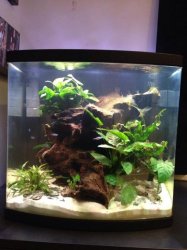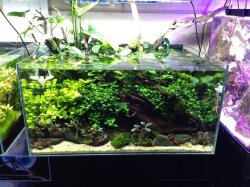Hi guys, wondering if you can help with an issue I'm having.
I set up a 90 litre nano on the 23rd of November 2015. The tank used to be a marine JBJ nanocube but I gutted it out and made it suitable for freshwater. The filtration is situated in the back of the tank behind a false backing panel. Water is drawn through 3 different chambers, through filter media & a heater before reaching the last chamber and being pumped back into the aquarium.
In the first chamber there is a heater. In the second there are two bags of ceramic bio rings, followed by fluval phosphate remover, followed by some filter floss which I change weekly, and finally a bag of purigen. In the last chamber is the return pump.
There a numerous plants in the tank, mainly anubias. The tank currently houses 8 cardinals, 4 leopard cories and a L201 snowflake pleco. The cardinals have been in the tank for around 3 weeks, the corys 2 weeks and the pleco one week. All are looking healthy and eating well.
My parameters have always been stable until perhaps the last two weeks where they have started to rise. I did not cure my bogwood properly before adding it, so have been experiencing a lot of tannin discolouration; to combat this I have been doing 50% water changes weekly. The last time I tested the water was last weekend and parameters were at the highest they have been.
PH = 7.5.
Ammonia = 0.1mg/l
Nitrite = 0.1mg/l
Nitrate = 15 mg/l
The thing bothering me is that I STILL have milky looking water. I cut back on feeding last week and am yet to see an impact, purigen doesn't seem to be helping either. Is there anything I can do or will it naturally settle itself? Should I continue to do water changes or leave it for a little while?
My other concern was that the filtration may be running "back to front" with the water passing through biological filtration first then the finer mechanical filtration (floss/purigen) after. Would this have an impact?
Any help or advice is greatly appreciated, thanks!
I set up a 90 litre nano on the 23rd of November 2015. The tank used to be a marine JBJ nanocube but I gutted it out and made it suitable for freshwater. The filtration is situated in the back of the tank behind a false backing panel. Water is drawn through 3 different chambers, through filter media & a heater before reaching the last chamber and being pumped back into the aquarium.
In the first chamber there is a heater. In the second there are two bags of ceramic bio rings, followed by fluval phosphate remover, followed by some filter floss which I change weekly, and finally a bag of purigen. In the last chamber is the return pump.
There a numerous plants in the tank, mainly anubias. The tank currently houses 8 cardinals, 4 leopard cories and a L201 snowflake pleco. The cardinals have been in the tank for around 3 weeks, the corys 2 weeks and the pleco one week. All are looking healthy and eating well.
My parameters have always been stable until perhaps the last two weeks where they have started to rise. I did not cure my bogwood properly before adding it, so have been experiencing a lot of tannin discolouration; to combat this I have been doing 50% water changes weekly. The last time I tested the water was last weekend and parameters were at the highest they have been.
PH = 7.5.
Ammonia = 0.1mg/l
Nitrite = 0.1mg/l
Nitrate = 15 mg/l
The thing bothering me is that I STILL have milky looking water. I cut back on feeding last week and am yet to see an impact, purigen doesn't seem to be helping either. Is there anything I can do or will it naturally settle itself? Should I continue to do water changes or leave it for a little while?
My other concern was that the filtration may be running "back to front" with the water passing through biological filtration first then the finer mechanical filtration (floss/purigen) after. Would this have an impact?
Any help or advice is greatly appreciated, thanks!


 /www.fishforums.net/index.php?/topic/246850-bacterial-blooms-explained/
/www.fishforums.net/index.php?/topic/246850-bacterial-blooms-explained/


